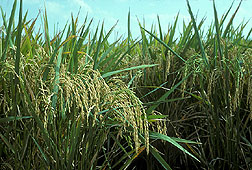Washington, DC, USA
August 19, 2010
 U.S. Department of Agriculture (USDA) scientists have developed a new tool for improving the expression of desirable genes in rice in parts of the plant where the results will do the most good.
U.S. Department of Agriculture (USDA) scientists have developed a new tool for improving the expression of desirable genes in rice in parts of the plant where the results will do the most good.
Roger Thilmony, a geneticist with USDA's Agricultural Research Service (ARS), has shown that the LP2 gene promoter can be used to direct other introduced genes to express beneficial traits in specific plant tissues without the potential for causing unintended consequences. Thilmony works at the ARS Crop Improvement and Utilization Research Unit in Albany, Calif. ARS is USDA's principal intramural scientific research agency.
Rice is under constant threat from pathogens such as rice blast, a fungus found in fields worldwide, and sheath blight, a continuing threat to U.S. growers. Scientists who develop disease-resistant varieties often find that introducing a gene may prevent disease in one part of the plant, but also may reduce seed quality or produce other "side effects" because the gene is expressed throughout the plant. Tissue-specific promoters, such as LP2, are segments of genes that can direct the activity of introduced genes only to parts of the plant where the beneficial traits are needed.
Thilmony and his ARS colleagues Mara Guttman, James Thomson and Ann Blechl found that the gene they named LP2 is consistently expressed in green tissues. In experiments, they fused the LP2 promoter with a "reporter gene" known to produce a specific enzyme, and inserted that fused DNA package into seven lines of rice to see where the enzyme would be produced.
They found that the LP2 promoter steered expression of the reporter gene specifically to green tissues where photosynthesis occurs. The reporter gene enzyme activity was highest in the leaves, and nearly undetectable in the roots, seeds and flower parts.
The LP2 promoter could be used to improve varieties of rice, barley and wheat and could aid in the development of biofuel crops, in which scientists need to control leaf traits without affecting other tissues, according to Thilmony.
The researchers published their work in Plant Biotechnology Journal and have filed a provisional patent on use of the LP2 promoter.
This research supports the USDA priority of promoting international food security.
Photo: Lemont rice, the first high-yielding semidwarf rice variety, was released by ARS and the Texas Experiment Station (Texas A&M University) in 1983. Photo by David Nance.
Nueva herramienta genética ayuda a mejorar el arroz
ientíficos con el Servicio de Investigación Agrícola (ARS) han desarrollado una nueva herramienta para mejorar la expresión de genes deseables de arroz en partes específicas de las plantas donde los resultados pueden ser lo mas útil posible.
Roger Thilmony, quien es genetista con el ARS, ha mostrado que el promotor genético LP2 puede ser usado para estimular la expresión por otros genes introducidos de rasgos beneficiosos en tejidos específicos de plantas sin el potencial de causar consecuencias no deseadas. Thilmony trabaja en la Unidad de Investigación del Mejoramiento y la Utilización de Cultivos mantenida por el ARS en Albany, California. ARS es la agencia principal de investigaciones científicas del Departamento de Agricultura de EE.UU. (USDA por sus siglas en inglés).
Hay muchas amenazas al cultivo de arroz, incluyendo enfermedades tales como el anublo del arroz. Los científicos que desarrollan nuevas variedades de arroz que tienen resistencia a estas enfermedades a menudo descubren que la introducción de un gen puede prevenir enfermedad en una parte de la planta, pero también podría reducir la calidad de los granos o causar otros efectos no deseados porque el gen se expresa por toda la planta. Los promotores genéticos que afectan tejidos específicos, tales como LP2, son segmentos de genes que pueden dirigir la actividad de los genes introducidos solamente en las partes de la planta donde se desean los rasgos beneficiosos.
Thilmony y sus colegas Mara Guttman, James Thomson y Ann Blechl con el ARS descubrieron que el gen conocido como LP2 se expresa coherentemente en los tejidos verdes. En experimentos, ellos fusionaron el promotor genético LP2 con un gen reportero que produce una enzima específica, y introdujeron este paquete de DNA en siete líneas de arroz para observar dónde la enzima se expresa.
Ellos descubrieron que el promotor LP2 causa la expresión del gen reportero específicamente en los tejidos verdes donde ocurre la fotosíntesis. La actividad del gen reportero fue la más alta en las hojas, y fue casi imperceptible en las raíces, las semillas y las flores de la planta.
El promotor LP2 podría ser usado para mejorar variedades de arroz, cebada y trigo y podría facilitar el desarrollo de cultivos para biocombustible, en los cuales los científicos tienen que controlar los rasgos de las hojas sin afectar otros tejidos, según Thilmony.
Los investigadores han publicado sus hallazgos en la revista 'Plant Biotechnology Journal' (Revista de Biotecnología de Plantas) y están solicitando una patente provisional sobre la utilización del promotor LP2.
Esta investigación apoya la prioridad del USDA de promover la seguridad alimentaria internacional.